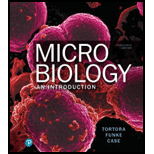
Microbiology: An Introduction Plus Mastering Microbiology with Pearson eText -- Access Card Package (13th Edition) (What's New in Microbiology)
13th Edition
ISBN: 9780134688640
Author: Gerard J. Tortora, Berdell R. Funke, Christine L. Case, Derek Weber, Warner Bair
Publisher: PEARSON
expand_more
expand_more
format_list_bulleted
Concept explainers
Question
Chapter 24, Problem 3A
Summary Introduction
To write:
Problems in adding influenza vaccine in the childhood vaccinations.
Given:
Cold and influenza vaccinations are prevented from adding it to the childhood vaccinations.
Introduction:
Influenza vaccine acts against the influenza viral strains. There are several strains that cause influenza. So it could be difficult to get vaccine for influenza but for prevention, children are advised to get the trivalent and quadrivalent vaccine each year.
Expert Solution & Answer
Want to see the full answer?
Check out a sample textbook solution
Students have asked these similar questions
Briefly state the physical meaning of the electrocapillary equation (Lippman equation).
Explain in a small summary how:
What genetic information can be obtained from a Punnet square? What genetic information cannot be determined from a Punnet square?
Why might a Punnet Square be beneficial to understanding genetics/inheritance?
In a small summary write down:
Chapter 24 Solutions
Microbiology: An Introduction Plus Mastering Microbiology with Pearson eText -- Access Card Package (13th Edition) (What's New in Microbiology)
Ch. 24 - DRAW IT Show the locations of the following...Ch. 24 - Compare and contrast mycoplasmal pneumonia and...Ch. 24 - Prob. 3RCh. 24 - Complete the following table.Ch. 24 - Under what conditions can the saprophytes...Ch. 24 - Prob. 6RCh. 24 - List the causative agent, mode of transmission,...Ch. 24 - Prob. 8RCh. 24 - Prob. 9RCh. 24 - Prob. 10R
Ch. 24 - Prob. 1MCQCh. 24 - No bacterial pathogen can be isolated from the...Ch. 24 - Prob. 3MCQCh. 24 - Match the following choices to the culture...Ch. 24 - Prob. 5MCQCh. 24 - Match the following choices to the culture...Ch. 24 - Prob. 7MCQCh. 24 - Prob. 8MCQCh. 24 - Prob. 9MCQCh. 24 - Prob. 10MCQCh. 24 - Prob. 1ACh. 24 - Prob. 2ACh. 24 - Prob. 3ACh. 24 - In August, a 24-year-old man from Virginia...Ch. 24 - Prob. 2CAECh. 24 - Prob. 3CAE
Knowledge Booster
Learn more about
Need a deep-dive on the concept behind this application? Look no further. Learn more about this topic, biology and related others by exploring similar questions and additional content below.Similar questions
- Not part of a graded assignment, from a past midtermarrow_forwardNoggin mutation: The mouse, one of the phenotypic consequences of Noggin mutationis mispatterning of the spinal cord, in the posterior region of the mouse embryo, suchthat in the hindlimb region the more ventral fates are lost, and the dorsal Pax3 domain isexpanded. (this experiment is not in the lectures).a. Hypothesis for why: What would be your hypothesis for why the ventral fatesare lost and dorsal fates expanded? Include in your answer the words notochord,BMP, SHH and either (or both of) surface ectoderm or lateral plate mesodermarrow_forwardNot part of a graded assignment, from a past midtermarrow_forward
- Explain in a flowcharts organazing the words down below: genetics Chromosomes Inheritance DNA & Genes Mutations Proteinsarrow_forwardplease helparrow_forwardWhat does the heavy dark line along collecting duct tell us about water reabsorption in this individual at this time? What does the heavy dark line along collecting duct tell us about ADH secretion in this individual at this time?arrow_forward
arrow_back_ios
SEE MORE QUESTIONS
arrow_forward_ios
Recommended textbooks for you
- Case Studies In Health Information ManagementBiologyISBN:9781337676908Author:SCHNERINGPublisher:Cengage
- Understanding Health Insurance: A Guide to Billin...Health & NutritionISBN:9781337679480Author:GREENPublisher:Cengage



Case Studies In Health Information Management
Biology
ISBN:9781337676908
Author:SCHNERING
Publisher:Cengage

Understanding Health Insurance: A Guide to Billin...
Health & Nutrition
ISBN:9781337679480
Author:GREEN
Publisher:Cengage

